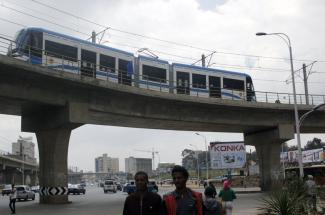Global governance
Daunting challenges in implementing SDGs

The SDGs were defined in an innovative and interactive process. Some elements were bottom-up, others top-down. Many different stakeholders were involved. Appropriate consideration was given to the three key dimensions of sustainability (social, economic and environmental). The policy process engaged developed as well as developing countries. It tackled poverty, climate change, inequality, peace and many other global challenges. The principle of “leaving no one behind” was addressed in rich and poor countries alike. All in all, the SDGs add up to a sensible agenda that can safeguard humanity’s future.
Therefore, it was appropriate to celebrate this global agreement. Implementing it, however, will be an even more challenging job than setting the agenda. Serious controversies have taken place between developed and developing countries concerning the means of implementation (MoI). Every SDG includes MoI targets, and SDG 17 especially spells out that MoI must be strengthened. Further debate on the matter is certain to come. MoI are about funding, technology transfer and capacity building, but they also concern policy coordination, improving governance and refined data collection and statistics. The global partnership must be built, with all parties assuming responsibility.
These issues matter very much because the SDGs do not add up to an agenda that can be easily implemented. Indeed, implementation will prove quite challenging for four main reasons:
- The first challenge concerns the MoI. Many countries lack the resources and capacities they need to achieve the SDGs. To a considerable extent, they are unable to provide public goods at the national level, and now they are being asked to contribute to providing public goods at the global level. Internationally coordinated efforts are needed to enable them to do so. In the past, advanced countries supported less advantaged countries with official development assistance (ODA). ODA, however, has been becoming less relevant in recent years, not least because established donors’ efforts decreased after the global financial crisis of 2008. Emerging powers such as China have been adopting new strategies towards developing countries, especially in Africa, combining development assistance and economic cooperation. Nonetheless, the overall picture is not promising. Coordination among different stakeholders, namely the donors, the recipient countries and international institutions, has not been addressed properly.
- The second challenge is that the SDGs are diverse, complex and interconnected. It has been suggested that countries should define priority SDGs rather than trying to tackle all SDGs at once. Understanding inter-linkages among the different goals can enhance the effectiveness of policy action as progress on one goal can drive progress on others. On the other hand, some goals may prove to be in conflict with one another. For example, there are trade-offs between promoting economic growth for poverty alleviation (SDG 1) and protecting terrestrial ecosystems (SDG 15). Both synergies and trade-offs must be considered thoroughly. Otherwise, it will be impossible to facilitate international harmony on SDG implementation.
- The third challenge is national governance. Private sector companies and civil society can play important roles in SDG implementation, but national governments must assume leadership in raising awareness, mobilising resources and carrying out national strategies. Unfortunately, lack of adequate governing capacity is not just a common symptom of underdevelopment – many experts consider it a core cause of underdevelopment. Weak governance is thus a pressing issue that must be addressed. ODA in terms of funding and capacity building can help, but it is indispensable that all national governments assume responsible ownership.
The fourth challenge is to monitor progress adequately. The SDG agenda has 17 goals, 169 targets and 231 indicators. Such complexity is a major implementation hurdle. Making matters worse, some indicators lack interim time targets, and there is no mechanism to enforce them. Others use ambiguous terms such as “sustainable”, “substantial” or “efficient”. At the same time, it is important to avoid the common fallacy of considering quantitative indicators to be more important than qualitative indicators. To tackle such problems, a comprehensive indicator framework would be useful. Real-time report cards could contribute to measuring progress and ensuring stakeholders’ accountability. Promising work on these matters has begun. One such example is the SDG Index and Dashboards, which was created by the UN Sustainable Development Solutions Network (SDSN) as a complementary tool to the official SDG indicators (Sachs et al., 2016). This is a good start, but much more needs to happen.
Adaptive governance
These challenges imply that the SDGs cannot be achieved simply by telling administrative agencies to implement the agenda. In the process, policymakers will have to take new decisions continuously, taking into account examples of success as well as failure. New governance mechanisms must be explored and developed (Xue, 2012). This means that the international community needs an approach of adaptive governance, at both national and global levels.
There is no universally accepted definition of “adaptive governance”, but several features are generally appreciated:
- Adaptive governance recognises complexity and uncertainty. There are always some conflicting goals in policy implementation, and implementation is best understood as a continuous experimental process.
- Adaptive governance is not simply about decentralisation in the sense of delegating responsibilities to sub-national levels. Proper alignment between national and sub-national institutions is essential.
- Adaptive governance respects the importance of local contexts and experiences.
- Adaptive governance is evolutionary, with goals and practices being reassessed periodically as a matter of course.
All summed up, the process of policy-making and policy-implementation should be organised as a learning system. Achieving the SDGs will require intensive international exchange and the involvement of national governments as well as other relevant actors. We propose an iterative approach with four reoccurring steps:
- Step 1: Use the SDGs as a comprehensive framework of development goals and identifying a country’s current status. The point is to identify development gaps, trade-offs and synergies in order to be able to act in the most efficient and effective way.
- Step 2: Identify development priorities through domestic policy process and strategise implementation accordingly. It would be unrealistic to try to close all gaps at once. Priorities must be identified to move forward efficiently. Setting priorities is fundamentally a political process that should involve all important stakeholders, with the most vulnerable groups deserving particular attention. Urban elites must not crowd out all others. A balance must also be struck between short-term needs and long-term threats. All this must be done in a way that fits the respective political order.
- Step 3: Create platforms to encourage mutual learning and experience sharing. Regional and thematic groups can also be created for various specific goals. The UN Sustainable Development Solutions Network has recently launched proposals on the matter (SDSN, 2017).
- Step 4: Review and revise priorities and implementation strategies periodically. Such revision, of course, is not an end point, but serves to start a new round of iterative learning. In any case, good practices should be copied, and mistakes made by others should be avoided.
The SDGs offer an unprecedented opportunity for global development. It is the common vision for human society to maintain peace, ensure the dignity of all and eradicate poverty. All stakeholders involved should keep learning from recently made experiences and shoring up their act, then the SDGs may become a reality rather than a fond memory by the year 2030.
Lan Xue is a professor and dean of the School of Public Policy and Management at Tsinghua University in Beijing, and co-chair of the Leadership Council of the UN Sustainable Development Solutions Network.
xuelan@tsinghua.edu.cn
Lingfei Weng is a post-doctoral research fellow of the School of Public Policy and Management at Tsinghua University.
wenglingfei@tsinghua.edu.cn
Hanzhi Yu is a post-doctoral research fellow at the Centre for International Governance Innovation in Canada.
hyu@cigionline.org
References
Sachs, J., Schmidt-Traub, G., Kroll, C., Durand-Delacre, D., and Teksoz, K., 2016: SDG index and dashboard-global report. Bertelsmann Stiftung and Sustainable Development Solutions Network: New York; 3-35.
SDSN, 2017: Solutions Initiatives.
http://unsdsn.org/what-we-do/solutions-initiatives/
Xue, L., 2012: The shifting global order: A dangerous transition or an era of opportunity? In Governance 25, Vol. 4: p. 535-539.










